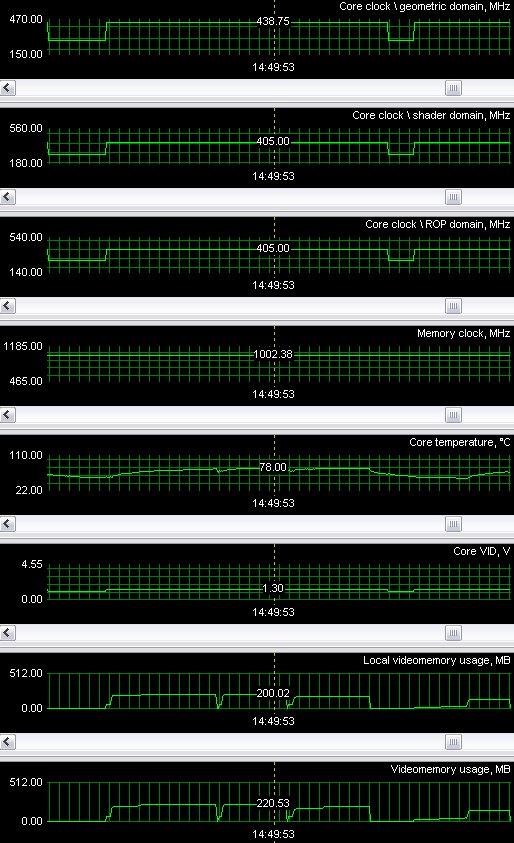ASUS Extreme N7800GT PCI-E 256MB
ASUS Extreme N6600GT Silencer PCI-E 256MB
Based on NVIDIA GeForce 6600GT/7800GT
|
TABLE OF CONTENTS
- Introduction
- Video cards' features
- Testbed configurations, benchmarks
- Test results
- Conclusions
Even though October and early November are full of announcements of new 3D accelerators, we still keep tabs on production-line video cards from previous series. One of such representatives was launched just a couple of months ago - we mean the GeForce 7800GT. The second card is a middle-aged product (relatively, of course!), it has already gained popularity due to its excellent price/performance ratio. Plus its state-of-the-art features. Of course, we speak of the GeForce 6600GT. Both accelerators are manufactured by ASUSTeK. Manufactured in the true sense of this word! It's has become fashionable among video card manufacturers to buy ready cards from a chip maker and sell them under their own brand without putting anything of their own into the manufacturing process. But in this case even the 7800GT is not a purchased reference card with an ASUS sticker, this card is manufactured by this company. Both products are sky-blue, a traditional ASUS color for the last couple of years (they had better be of a different color though: many vendors use the blue color; for example, it's a traditional color of video cards from Gigabyte, Chaintech, and others). ASUS used to manufacture violet-colored cards some time ago. But the manufacturers abandoned this unique color for some reason - even though it might have become a specialty. Considering a rainbow in the company's logo, any unique PCB color would have done). So, while everything is quite clear with the 7800GT, this 6600GT is not just a regular card. Firstly, it has 256MB of memory, which is not typical of a 6600GT, as NVIDIA didn't announce such a reference card. Secondly, the cooling system is special: no fans as such, a heatsink of an intricate form, which is installed far beyond the card itself. Let's have a closer look at it.
Video Cards
| ASUS Extreme N7800GT PCI-E 256MB |
| Interface: PCI-Express x16 Frequencies (chip/memory — physical (memory — effective): 400/500 (1000) MHz (nominal - 400/500 (1000) MHz) Memory bus width: 256bit Number of vertex pipelines: 7 Number of pixel pipelines: 20 Dimensions: 200x100x15mm (the last figure is the maximum thickness of a video card). PCB color: blue. Output connectors: 2xDVI, S-Video. VIVO: available (Philips 7115) TV-out: integrated into GPU. |

|
| ASUS Extreme N6600GT Silencer PCI-E 256MB |
| Interface: PCI-Express x16 Frequencies (chip/memory — physical (memory — effective): 500/500 (1000) MHz (nominal - 500/500 (1000) MHz) Memory bus width: 128bit Number of vertex pipelines: 3 Number of pixel pipelines: 8 Dimensions: 175x100x22mm (the last figure is the maximum thickness of a video card). We don't take into account dimensions of the remote part of the heatsink, as it can be rotated to find a convenient position. PCB color: blue. Output connectors: DVI, d-Sub, S-Video. VIVO: not available TV-out: integrated into GPU. |
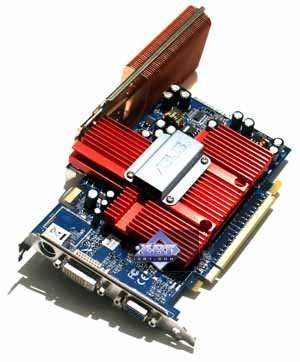
|
| ASUS Extreme N7800GT PCI-E 256MB |
| The video card has 256 MB of GDDR3 SDRAM allocated in eight chips on the front side of the PCB. Infineon memory chips (GDDR3). 2.0ns memory access time, which corresponds to 500 (1000) MHz. |
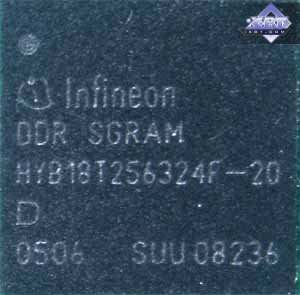
|
| ASUS Extreme N6600GT Silencer PCI-E 256MB |
| The video card has 256 MB of GDDR3 SDRAM allocated in eight chips on the front and back sides of the PCB. Samsung (GDDR3) memory chips. 2.0ns memory access time, which corresponds to 500 (1000) MHz. |
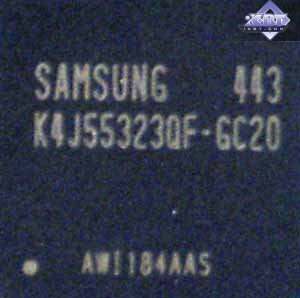
|
| Comparison with the reference design,
front view |
|
ASUS Extreme N7800GT PCI-E 256MB
|
Reference card NVIDIA GeForce 7800GT
|
|
|
|
|
|
|
ASUS Extreme N6600GT Silencer PCI-E 256MB
|
Reference card NVIDIA GeForce 6600GT
|
|
|
|
|
|
| Comparison with the reference design,
back view |
|
ASUS Extreme N7800GT PCI-E 256MB
|
Reference card NVIDIA GeForce 7800GT
|
|
|
|
|
|
|
ASUS Extreme N6600GT Silencer PCI-E 256MB
|
Reference card NVIDIA GeForce 6600GT
|
|
|
|
|
|
So, the 7800GT is obviously a copy of the reference design! To the joy of quietness fans, the latest RivaTuner version copes well with controlling the rotational speed of the fan on this cooler. The product based on 6600GT resembles the reference card, but there are some differences. First of all, the back of the PCB had to accommodate memory chips (256 MB of GDDR3 256Mbit modules require 8 chips, so 4 of them are installed on the back of the card). The VIVO coder seat disappeared, it had been often empty on such cards from most manufacturers. The main feature of this card is certainly its cooling system.
| ASUS Extreme N6600GT Silencer PCI-E 256MB |
|
It's a very complex and intricate device on the face of it. However, all this multitude of screws, nuts, angle pieces hides an interesting system: the card is equipped with a large heatsink, which uses a heat pipe to channel the heat to the second pin-fin copper heatsink. We have already come across this many times, the second heatsink mounted at the back of the card and the heat pipe bending around the card on top or at the side. Such a design might have worked in this case as well, though a 500 MHz NV43 gets quite hot. Besides, the primary heatsink channels the heat away from memory chips on the front side of the card. However, the main disadvantage of the cooling system with two heatsinks is insufficient cooling for the second heatsink. When it's pressed to the PCB, it blocks the cool air flow from PC case fans. Lifting this heatsink ABOVE the card provides a good cooling effect and the rotation capacity allows flexibility in arranging the heatsink inside a PC case (for example, the air usually flows past a CPU cooler, so placing a copper pin-fin heatsink of the video card on this way is very useful; besides, the hot air is driven out of a PC case). Of course, some users will find this cooling system clumsy, ridiculous, and even impeding (there exist different PC cases). I just agree that this cooler is not very graceful. It looks as though it's assembled from improvised angle pieces and other materials. But I repeat that it's truly efficient, the engineers did a good job. Well, the design may be disputable, though all you will be able to see from a window at the side of your PC case (if there is a window at all) is the top copper heatsink, which looks good.
|

|

|

|
| ASUS Extreme N7800GT PCI-E 256MB |
|
On the whole, the cooler resembles the reference design. It also consists of a central copper heatsink on a core, curved heatsink on memory chips, and a cover with a fan. It forms closed space to blow the air through. The cooler is narrow but it still requires much empty space around the card for better cooling. You can watch a video and evaluate the noise at this link (2.9MB, AVI DivX 5.1). The cooler is illuminated, so the cover of the cooling device is partially made of semitransparent plastic. We have already come across this cooling system many times, it appeared in times of the GeForce 6800 Gamers Edition.
|
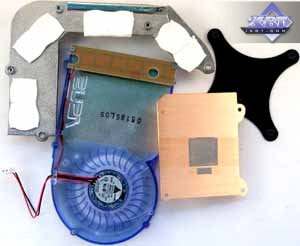
|
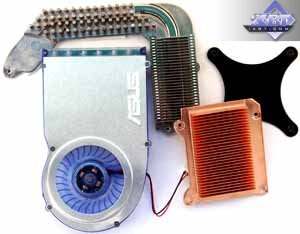
|
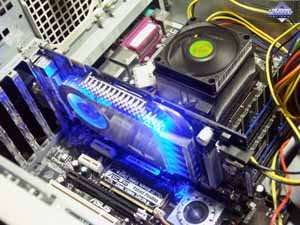
|
The 7800GT is equipped with two DVI connectors, while the 6600GT has d-Sub and DVI. You can also see that the first card is equipped with Philips 7115 coder, thus the device supports VIVO. This is not the case with the 6600GT.
Bundle
| ASUS Extreme N7800GT PCI-E 256MB |
| User's manual, CD with drivers, games (you can see the list on a photo), DVI-to-d-Sub, HDTV/VIVO adapters, external power cable. |
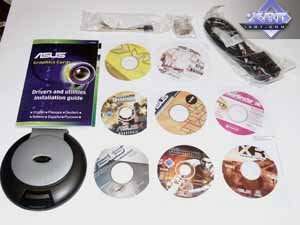
|

|
| ASUS Extreme N6600GT Silencer PCI-E 256MB |
| User's manual, CD with drivers, DVI-to-d-Sub, HDTV, SVideo-to-RCA adapters, games. |

|
Packages.
| ASUS Extreme N7800GT PCI-E 256MB |
|
Both cards have identical packages, the boxes differ only by labels and writings. |
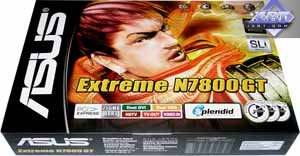
|
| ASUS Extreme N6600GT Silencer PCI-E 256MB |
|
These products are packaged in boxes made of thick white cardboard inside bright covers. |

|
Installation and Drivers
Testbed configurations:
- Athlon 64 (939Socket) based computer
- CPU: AMD Athlon 4000+ (2400MHz) (L2=1024K)
- Motherboard: ASUS A8N SLI Deluxe based on NVIDIA nForce4 SLI
- RAM: 1 GB DDR SDRAM 400MHz (CAS (tCL)=2.5; RAS to CAS delay (tRCD)=3; Row Precharge (tRP)=3; tRAS=6)
- HDD: WD Caviar SE WD1600JD 160GB SATA
- Athlon 64 (754Socket) based computer:
- CPU: AMD Athlon 64 3700+ (2400MHz) (L2=1024K)
- Motherboard: ASUS K8V SE Deluxe based on VIA K8T800
- RAM: 1 GB DDR SDRAM PC3200 (CAS (tCL)=2.5; RAS to CAS delay (tRCD)=3; Row Precharge (tRP)=3; tRAS=6)
- HDD: Seagate Barracuda 7200.7 80GB SATA
- Operating system: Windows XP SP2 DirectX 9.0c
- Monitors: ViewSonic P810 (21") and Mitsubishi Diamond Pro 2070sb (21").
- ATI Drivers 6.571 for PCI-E video cards (CATALYST 5.9); NVIDIA drivers 81.84.
VSync is disabled. A few words on overclocking. Here are the frequencies we managed to get:
- ASUS Extreme N7800GT PCI-E 256MB: 459/1150 MHz
- ASUS Extreme N6600GT Silencer PCI-E 256MB: 525/1170 MHz
As we can see, the card does not get heated much at standard frequencies (we tested it in a closed PC case without additional cooling of the card).
When the frequencies are raised to 459/1150 MHz, the heating grows, but not as critical as to require additional cooling. Unfortunately, artifacts started to appear already at 486 MHz on the core, so this sample couldn't be overclocked.
Test results: performance comparison
We used the following test applications:
Summary performance diagrams for PCI-Express video cards
- 1. Far Cry, Research
- 2. Splinter Cell Chaos Theory
- 3. Half Life2, ixbt01
- 4. DOOM III
- 5. 3DMark05 MARKS
- 6. Chronicles of Riddick, demo 44
- 7. F.E.A.R. (MP)
Conclusions
- ASUS Extreme N7800GT PCI-E 256MB is an attractive and stylish product, based on the popular GeForce 7800 GT. It uses its own cooling system (hence the attractiveness :-), but we can still control the rotational speed of the fan in RivaTuner to make it nearly noiseless. In other respects, this product features all advantages of the 7800 GT, we wrote about them many times. I'd like to note the good bundle, excellent assemblage quality of the card, good overclocking potential, excellent 2D quality. Of course, the price as well as brand preferences will play a major role in this choice.
- ASUS Extreme N6600GT Silencer PCI-E 256MB is a usual 6600GT in the original implementation. There are two main advantages: 256 MB of memory (which is already important for these days) and a noiseless cooler. The latter has a number of its own advantages: flexible accommodation inside a PC case thanks to rotating the upper heatsink; good cooling even for such a hot chip as the 6600GT. On the whole, the overheating is rather high, but not critical. 2D quality is excellent, there were no problems with stability.
You can find more detailed comparisons of various video cards in our 3Digest.
ASUS Extreme N7800GT PCI-E 256MB and ASUS Extreme N6600GT Silencer PCI-E 256MB get the Original Design award (November).
Write a comment below. No registration needed!
|
|
 |
|
|
|

